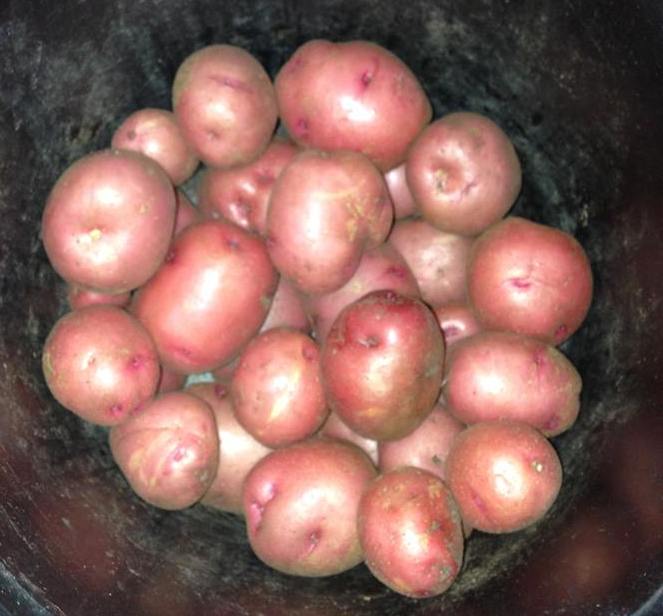
by Julie McConnell | Feb 3, 2016
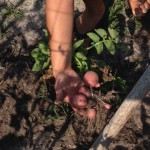
Potatoes planted in mid-February were ready to harvest in mid-May in Panama City. Photo: Vicki Evans, UF/IFAS Master Gardener
A common misconception is that all potatoes come from the Midwest. However, select Irish potato varieties are produced commercially in Florida on over 20,000 acres. Potatoes can also be grown in Florida home gardens if care is taken to select the correct type and recognize proper timing.
Potatoes are a cool season crop and the ideal time to plant in the Florida Panhandle is in January and February. Valentine’s Day is a good target planting date for home gardeners with plants producing tubers after about three months (variety and weather dependent).
The ideal site for potatoes has well-drained soils with a pH range of 5-6. To increase drainage, beds can be formed into hills that are 10-12 inches above the soil. Another option is to grow potatoes in raised beds or containers to ensure the plants will not sit in water during heavy rains.
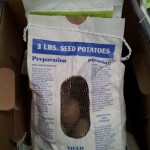
Certified seed potatoes are available in garden centers. Photo: Julie McConnell, UF/IFAS
Use certified “seed” potatoes to ensure you are starting with healthy tubers. Cut seed potatoes into egg sized pieces that contain at least one eye each. Allow the cut seed pieces to heal for a couple of days in a cool, dark spot with good ventilation. After healing they can be planted about four inches deep 6-8 inches apart with three feet between rows.
Sometimes potatoes will push to the surface of the soil and will need to be covered with more soil (hilling). If the potatoes are not covered, they can become damaged by the sun and inedible.
Keep your garden weed free to minimize competition with your crop and to also reduce the likelihood of weeds harboring insects or disease that can be harmful to potato plants.
A few weeks after planting seed potatoes, you should begin to see some vegetative (leaves and stems) growth above the soil. Potato plants can grow over a foot tall and are bushy. Small new tubers start to form underground before blooming, but they need more time to bulk up before harvesting. The entire growing process takes between 80 and 115 days from planting to harvest.
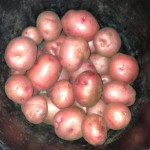 If you plan to store your potatoes, allow them to remain in the ground for 2-3 weeks after the top of the plant has died to fully mature. If the vegetative portion of the plant does not die on its own the top can be cut to induce maturation of the tubers.
If you plan to store your potatoes, allow them to remain in the ground for 2-3 weeks after the top of the plant has died to fully mature. If the vegetative portion of the plant does not die on its own the top can be cut to induce maturation of the tubers.
For recommended varieties and more information on care and harvesting please see “Growing Potatoes in the Florida Home Garden.”
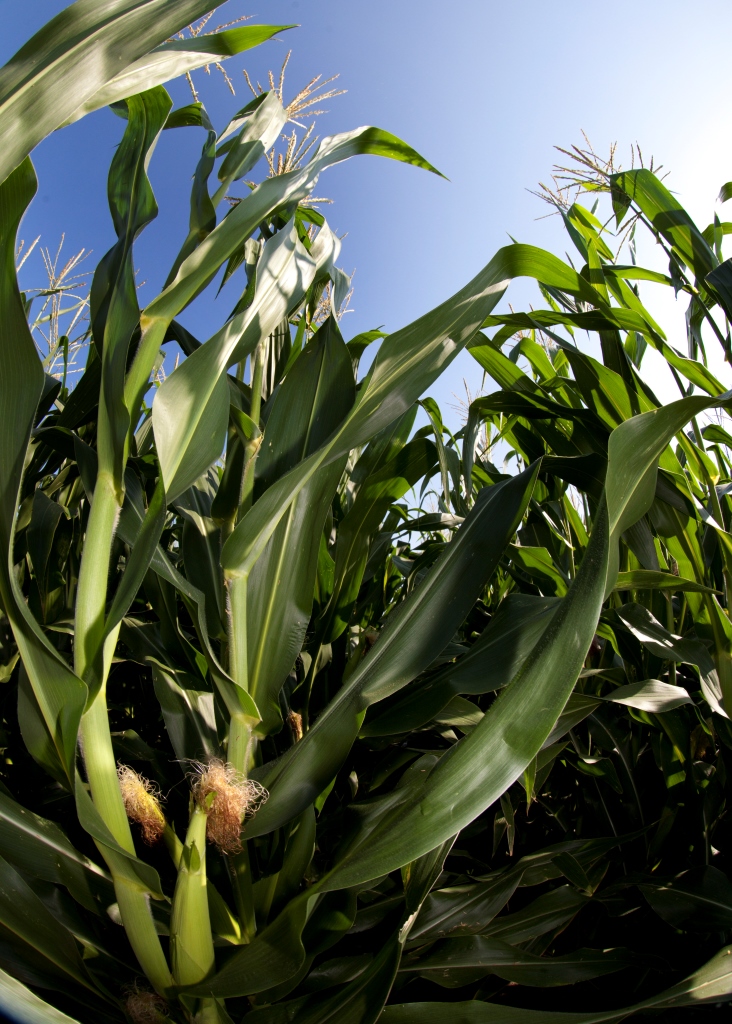
by Judy Biss | Feb 3, 2016

Corn tassels at the top provide the pollen needed to produce the perfect ear of corn on the stalk below. UF/IFAS Photo by Tyler Jones.
It won’t be long until row crops and vegetable gardens are planted and thriving once again next spring. A sometimes taken for granted, yet critical element of any prosperous crop is successful pollination. Most of us know what “text book” pollination means, but did you know in cucurbit plants, (squash, melon, pumpkin) at least 1,000 grains of pollen must be evenly deposited in each bloom to produce a uniform marketable fruit? Or, to grow our favorite summer delight, each watermelon flower must be visited by a honeybee a minimum of 8 times? And how about the fact that each silk in a corn flower is connected to one kernel on the ear of corn, and for the kernel to develop properly pollen must travel down the silk through a pollen tube to the waiting kernel? Add to these facts the dizzying variety of pollen and flowers, bloom times, pollination dynamics, weather conditions, plant growth, and availability of pollinator insects, then one can begin to see how amazing pollination is, and how critical it is to our food supply.
What are the basics of pollination?
The first step of fruit or vegetable reproduction takes place when flowers emerge. Plant flowers can be male, female, or perfect flowers. The male flowers produce pollen. The female flowers have ovaries which, when fertilized, become the fruit or vegetable. “Perfect” flowers have both male and female parts within a single flower. Most garden vegetables such as beans, peppers, and tomatoes have perfect flowers, whereas cucurbits like squash, pumpkins and watermelon, have separate male and female flowers on the same vine. For successful pollination to occur, the male pollen must reach the female ovaries in order for the fruit or vegetable to be produced.
Methods of Pollinating
Transfer of pollen to the plant ovaries for fruit and vegetable production, whether in the same “perfect” flower, or in another separate female flower, occurs in several ways. Some plants, like corn, depend on wind to transfer pollen to the silk, and ultimately ovaries, of the female flower. Other plants, like squash depend on the help of pollinators like insects to deliver the pollen to the ovaries. Plants that produce perfect flowers can self-pollinate, but still benefit from contact with pollinators. In small backyard gardens, many crops in the cucurbit family (squash, melons, etc.) or those that have separate male and female flowers, can be pollinated by the gardener by hand. In the absence of insect pollinators in dooryard gardens, hand pollination will increase yields.
The Importance of Bees
Obviously, in production agriculture, hand pollination of crops is not feasible, and although some crops are wind pollinated, most crops need insect or animal pollinators to accomplish the job. As we know, bees are one of the most important pollinating insects, and it is well documented that yields of many fruit and vegetable crops increase in both quality and quantity when pollinated by honey bees. According to the UF/IFAS publication Minimizing Honey Bee Exposure to Pesticides:
The Business of Pollination
Because they are so critical to increased quality and quantity yields, managed honey bee colonies are used across the country in a thriving contractual pollination industry. According to the UF/IFAS publication Sample Pollination agreement,
The business of pollination is crucial to the agricultural industry in the United States. In Florida, the major need for pollination is in fruit and vegetable production.
And according to the UF/IFAS publication Minimizing Honey Bee Exposure to Pesticides,
Rental of honey bee colonies for pollination purposes is a highly demanded service and a viable component of commercial beekeeping and agriculture. Bee colonies are moved extensively across the country for use in multiple crops every year. There are also over 3,000 registered beekeepers in Florida, managing a total of more than 400,000 honey bee colonies and producing between 10–20 million pounds of honey annually.
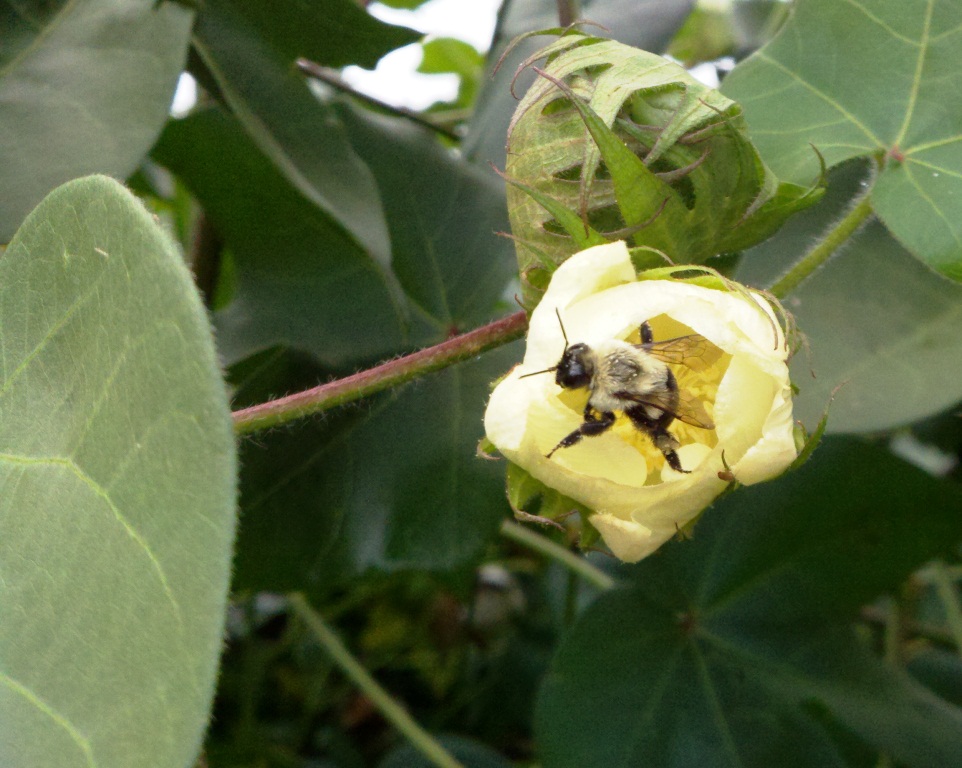
Cotton is largely self-pollinating, but attractive to bees. In some cotton varieties, pollination by bees can increase seed set per boll. Source: University of Georgia Pollination: Crop Pollination Requirements. Photo by Judy Biss
Crop Pollination Requirements
The dynamic of pollination is a fascinating and critical component of both dooryard and production agriculture. Research on plant health, varieties, growth, and potential, as well as research on honey bee colony health and management, all play a role in producing sustainable food yields. The University of Georgia has summarized pertinent literature related to common fruit and vegetable crop pollination requirements (Apple, Blueberry, Cantaloupe, Cucumber, Squash, Watermelon, Other Crops). This comprehensive resource provides the recommended number of beehives per acre for each crop, plus additional information on plant variety characteristics, and other useful information related to maximizing pollination and yield. Check it out: Pollination: Crop Pollination Requirements
So whether you have a dooryard garden or a large farm, it will benefit you to learn all there is to know about your crop’s pollination requirements to maximize yield and quality potential.
For more information on this topic, please see the following publications used as resources for this article:
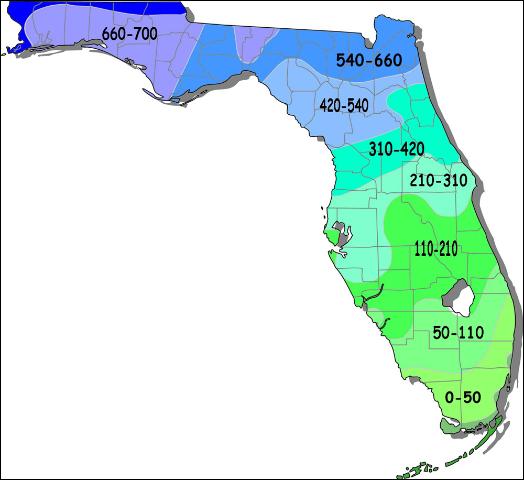
by Matt Lollar | Jan 27, 2016
We may be suffering from the recent low temperatures, but temperate fruit trees such as peaches and apples require a period of cold weather in order to become cold hardy and produce a good crop.
What is Cold Hardiness?
Cold hardiness is the ability of a plant to survive low temperatures. However, every cold event is fairly unique with variables such as when the low temperatures occur (early vs. late winter), how quickly the temperature drops, the temperatures in the days leading up to the event, and the length of time the low temperatures are sustained.
Cold Acclimation
Cold acclimation is the development of freezing tolerance in plants. Three fall environmental factors contribute to cold acclimation in fruit trees. Plant will develop 10 to 15 degrees of cold tolerance when the leaves sense shorter day lengths. Metabolic activity is increased when days are short and temperatures are between 60°F days and 40°F nights. The second factor occurs when lows reach the 20s, which can make trees up to 10 degrees hardier. The final factor occurs when temperatures dip to near zero, which fortunately for us does not occur very often.
Trees remain hardy during the winter as long as temperatures remain fairly stable. However, de-acclimation occurs in reaction to warm temperatures. This explains the winter flowering which occurred this past December. A cold snap may not injure trees unless it immediately follows a period of mild temperatures.

Florida Average Chill Hours Map – UF/IFAS Extension
Chilling Requirement
The cold weather and gradual cold acclimation are necessary to a tree’s accumulation of chill hours which is necessary for steady fruit yields. Chill hours are the accumulation of hours when temperatures are between 32°F and 45°F. The yearly average chill hour accumulation in Northwest Florida is between 660 and 700 hours. The apple varieties recommended for our area (‘Anna’, ‘Dorsett Golden’, and ‘TropicSweet’) have a chilling requirement of 250 to 300 hours. Some of the peach varieties recommended for our area (‘Flordacreast’, ‘Flordaking’, and ‘Gulfsnow’) have a chilling requirement of 350 to 400 hours. Please note the risk of planting these varieties because their chilling requirements are lower than our average chill hour accumulation. The varieties listed are for example, but other available varieties are suitable for our area.
Whether you like winter weather or not, just remember the satisfaction of eating fresh fruit in the summer. To track this year’s chill hours from the warmth of your home, please visit the AgroClimate tool at http://agroclimate.org/tools/Chill-Hours-Calculator/.
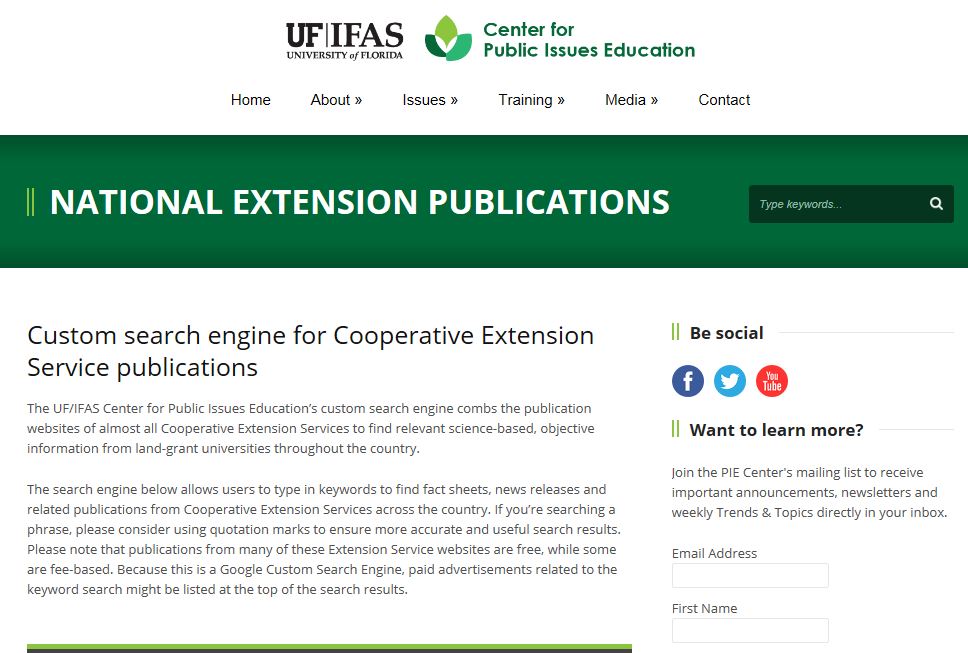
by Mary Salinas | Jan 27, 2016
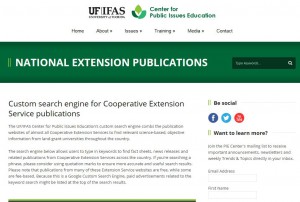 So often, we are searching for research-based information to solve our gardening questions but the search engine turns up all sorts of sites that we may or may not know and trust. There is now a better way to search for reliable gardening information from trusted universities. The University of Florida IFAS Center for Public Issues Education just announced on January 22, 2016 a custom search engine for Extension service publications. Many top land-grant universities are participating in this project to bring you facts sheets, news releases and other publications that are relevant and science-based.
So often, we are searching for research-based information to solve our gardening questions but the search engine turns up all sorts of sites that we may or may not know and trust. There is now a better way to search for reliable gardening information from trusted universities. The University of Florida IFAS Center for Public Issues Education just announced on January 22, 2016 a custom search engine for Extension service publications. Many top land-grant universities are participating in this project to bring you facts sheets, news releases and other publications that are relevant and science-based.
This valuable tool is not just for gardening information but for any topic that you would expect to be addressed by a university or Extension such as oysters, healthy living and raising chickens.
I have used it a few times to test it out and it works marvelously! Try it yourself!
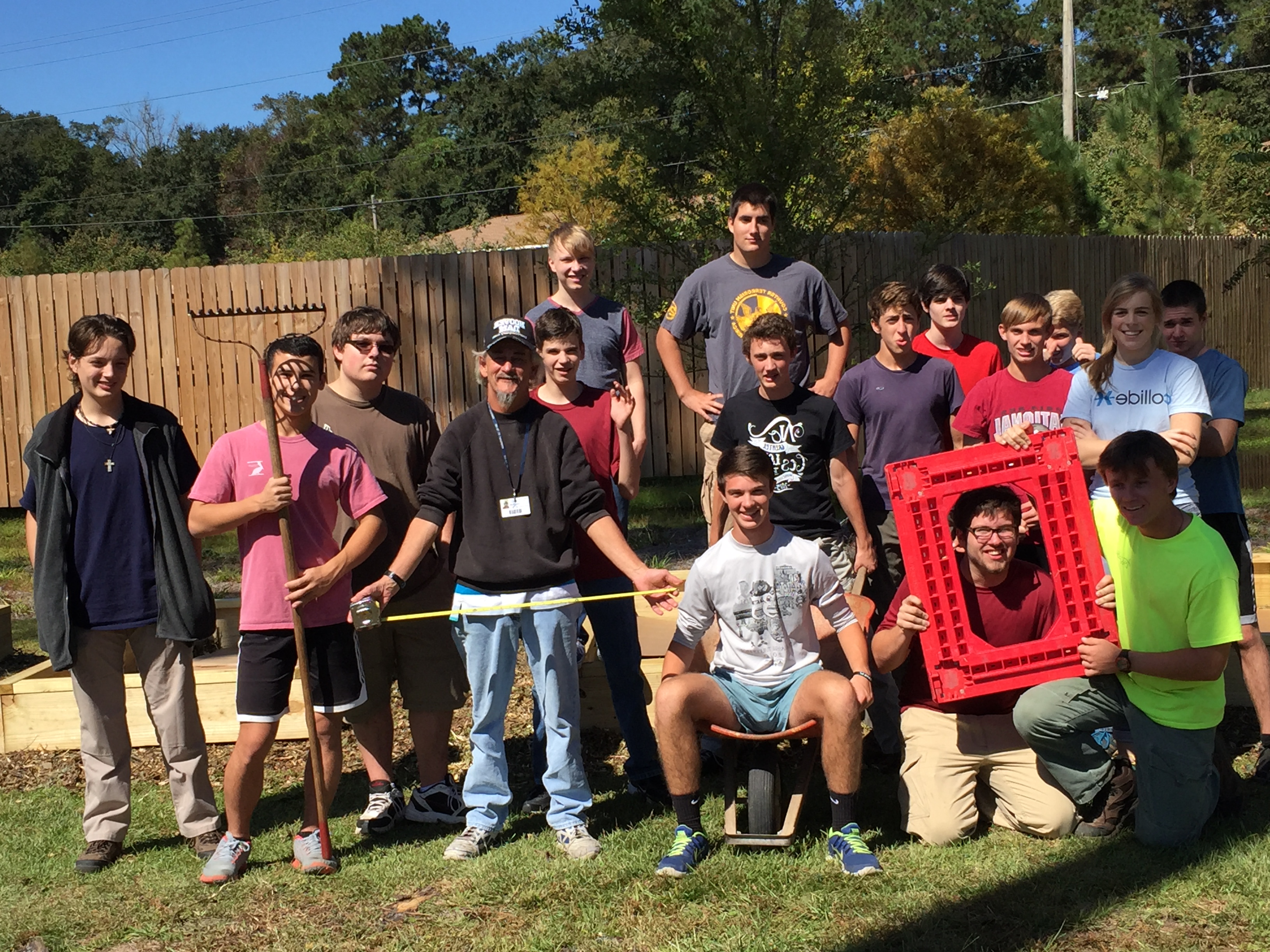
by Molly Jameson | Jan 13, 2016

Volunteers after lots of hard work mulching and adding compost to eight raised beds at The Shelter garden.
Have you ever been interested in volunteering at a school or community garden? Are you involved with a garden that could use some help? Well, UF/IFAS Leon County Extension recently started an Adopt-a-Garden program for volunteers to “adopt” a school or community garden for volunteer credit. Volunteers can teach hands-on gardening techniques, conduct educational talks and present displays at garden workdays, assist with garden planning and networking, encourage gardeners to work together, and help with any other activity that adds to the vitality of the garden. The program focuses on garden education and outreach as the primary objectives.

Volunteers hard at work planting fall vegetables in The Shelter garden.
The first major project of the Adopt-a-Garden program has been very exciting, with UF/IFAS Leon County Extension Master Gardeners “adopting” the new homeless shelter at the Kearney Center in Leon County. Master Gardeners lead the way in the organization and construction of eight raised bed vegetable gardens located on site directly behind The Shelter facility. They were awarded a community garden mini-grant from Leon County, which helped to cover garden supplies.
The Leon County Master Gardeners have received assistance from UF/IFAS Extension Agents, Florida State’s College of Social Work, and many other members of the community in gathering supplies and donations, recruiting volunteers, communicating with The Shelter staff, building and filling the raised beds, planting the garden, and maintaining the garden.
The gardening materials for The Shelter garden were generously supplied at no coast or at discounted costs by Lowe’s Home Improvement, Britt’s Dump Truck Services, Tallahassee Nurseries, Native Nurseries, Asplundh, and the FSU College of Social Work.
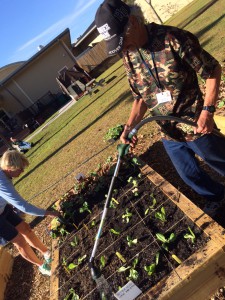
Shelter resident watering freshly planted lettuce.
Leon County Extension and Leon County’s Office of Resource Stewardship will conduct shelter resident and staff garden trainings to ensure the garden is maintained and successful going forward. Extension’s Family Nutrition Program is currently offering nutrition education classes to shelter residents as well.
This project will allow shelter residents to get hands-on experience working in a vegetable garden, learn about different vegetable varieties, and taste their harvest, as vegetables that are grown in the garden go directly to The Shelter kitchen for meal preparation. The garden was officially dedicated as the Wendy Crook Memorial Garden by Leon County Government, with the dedication event reported by local television station ABC 27 WTXL. The article and video clip can be viewed here.
Along with the Wendy Crook Memorial Garden, other school and community gardens have been “adopted” by volunteers. If you are in the Leon County area and are interested in becoming a volunteer with the Adopt-a-Garden program, you can find out more information at the Leon County Adopt-a-Garden website or contact Extension Agent Molly Jameson, at mjameson@ufl.edu. Volunteers are encouraged to team up on garden projects and all levels of gardening experience are welcome.
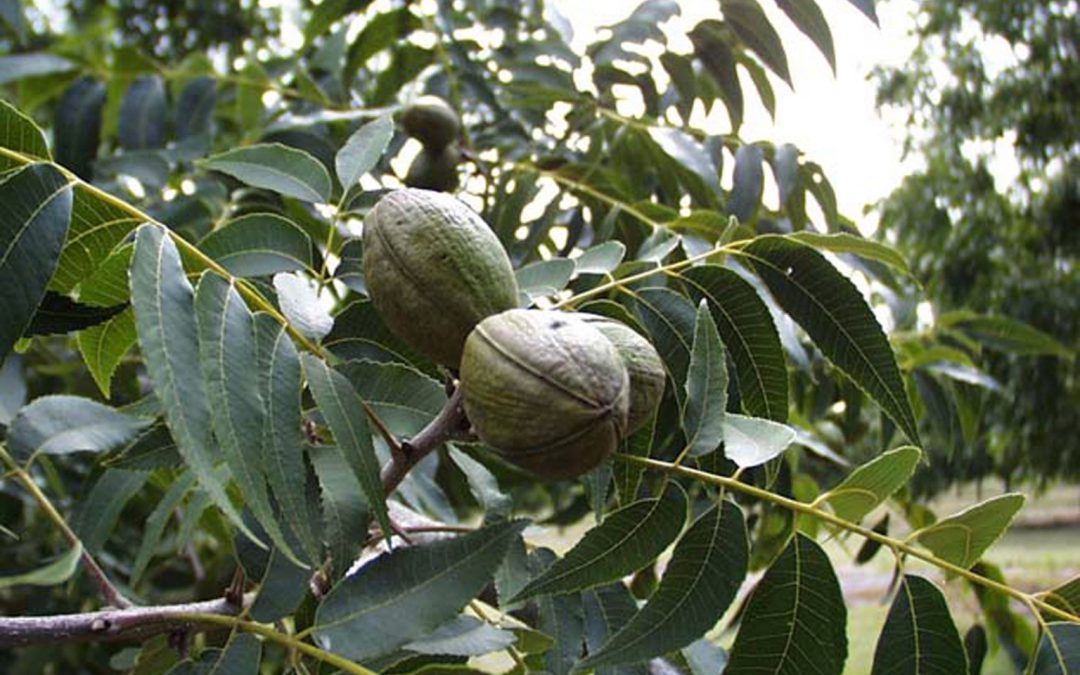
by Larry Williams | Jan 13, 2016
Pecan trees are well adapted to our area, making beautiful large shade trees. And, if the correct varieties are planted, they can provide pecans.
Only those pecan varieties that show some real resistance to disease problems are recommended for planting here in the humid south. Select grafted trees of Desirable, Curtis, Elliott, Moreland or Stuart varieties.
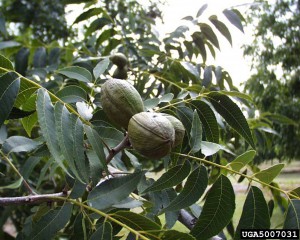
Pecan leaves and fruit. Photo credit: Brad Haire, University of Georgia, Bugwood.org
Obtain and plant your pecan trees during the winter – December through February. Purchase trees that are three to six feet tall. Larger trees are more difficult to transplant.
Give pecan trees plenty of room to grow. The distance between trees should be approximately sixty feet because mature trees are quite large. Commercial producers sometimes use a closer spacing, primarily because they are using varieties that will bear at an earlier age. But most of those varieties do not have good disease resistance and still require pesticide spray at times. Homeowners will not have the needed equipment to spray a large pecan tree and the drift from such sprays would not be desirable around your home, so commercial varieties aren’t recommended for home plantings.
One of the keys to survival of a pecan tree is not allowing the root system to dry out before, during or after transplanting. Regular watering will be required for a period of at least six months or until the young tree is well established. The planting hole should be 18 to 24 inches wide and only as deep as the root system. Spread the roots so they are not matted together. The planting depth is critical. Place at such a depth that the uppermost root is at or near the soil surface. Excessively deep planting can result in eventual death of the tree.
When planting your tree, there is no need or advantage to using peat moss, compost, manure or other organic matter in the planting hole. Plant the tree in the native soil without amendments.
Do not fertilize when the tree is planted. Wait until May of the first year after planning to apply fertilizer.
Remember that pecan trees are large at maturity, with branches spreading 30 feet or so from the trunk. Also, because of the brittle limbs and failing nuts, it’s best not to plant these trees too near the home, driveway or sidewalk.


 If you plan to store your potatoes, allow them to remain in the ground for 2-3 weeks after the top of the plant has died to fully mature. If the vegetative portion of the plant does not die on its own the top can be cut to induce maturation of the tubers.
If you plan to store your potatoes, allow them to remain in the ground for 2-3 weeks after the top of the plant has died to fully mature. If the vegetative portion of the plant does not die on its own the top can be cut to induce maturation of the tubers.










